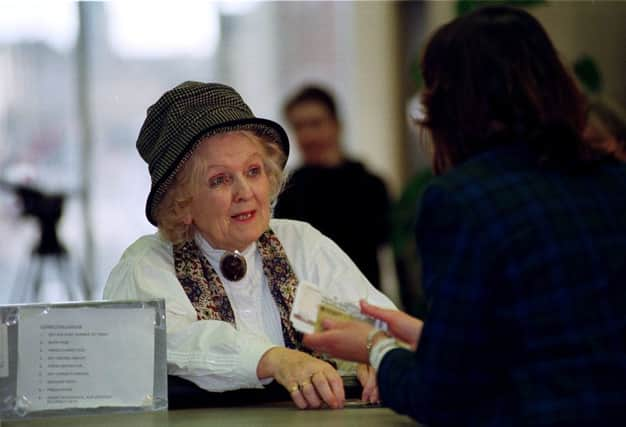Obituary: Elisabeth Fraser, author and seeker of spiritual truths who campaigned to save the Ladies Branch of RBS


At the memorial service held to remember and celebrate the amazing life of Elisabeth Fraser, those present were reminded of the exceptional life she led – her intelligence, her unbounding energy and the sweetness of her smile. Each day was a new adventure for her and she overcame even the most difficult situations with determination. Her grandson described her as compelling and determined, inspiring and driven, tenacious and persuasive. She died peacefully after a long life of experiences not known to many.
Born in Worcester in 1920 to Charles and Edith Averill, she was one of five; her brothers were the late Charles and John and her sister the late Marguerite and she is survived by her younger brother, Edward.
Advertisement
Hide AdAdvertisement
Hide AdShe grew up on a farm owned by her grandfather and had some difficulty with her schooling as she was already strong willed and not always able to accept the teachings given to her.
She trained as a nurse before getting wed in 1941, to Raymond Casebourne. The marriage produced four children, Edward, Kate, John and Paul.
An extraordinary event took place in her life in the 1950s when she entered the School of Universal Philosophy and Healing along with other members of her family. A restricted and hard life continued for some nine years and her departure from the school in the middle of the night was a hair-raising event which she later described in her book Fragments.
She escaped from the school with nothing and she and her future second husband, Alexander, left London with £20 in total between them and made for Scotland. She settled in her beloved Scotland for the rest of her life.
In 1965 she became a member of staff of The Scotsman at North Bridge, Edinburgh, and grew to be a valuable member of the classified sales department. She gained a diploma in the Principles and Practices of Classified Advertising which included sales techniques, copywriting and new paper productions.
Leaving The Scotsman, she joined Jarrolds Publishers of Norwich, where she built a successful career over 25 years. She was the Scottish representative for the company, her duties being to distribute books over the whole of Scotland.
She became extremely well known, touring the north and the Highlands and Islands in her van packed to the roof with books. She also had her own business selling cards and calendars throughout Scotland.
She became a very successful author, with books on the Scottish Highlands, Robert Burns and Auld Lang Syne to her name. Mrs Fraser’s Illustrated History of Scotland was a popular manual covering ground from Celts to The Enlightenment, recommended for schools and students. The précis to the book was written by His Grace the Duke of Atholl, who praised the book and its contents.
Advertisement
Hide AdAdvertisement
Hide AdMrs Fraser was one of the indomitable dames who opposed the closure of the Ladies Branch of the Royal Bank of Scotland.
Having been an investor with the Royal Bank since the Ladies Branch was opened in the West End of Princes Street she, along with others, expressed her displeasure at the closure, stating that the bank had been more like a wee club than a bank for ladies with accounts there.
Her memoir, Fragments,was well read and included her first encounter with the Indian philosopher Krishnamurti, who became her influence for the rest of her life. As she continued reading the Krishnamurti books, Mrs Fraser felt the need to meet the author and, with husband Alexander’s help, learned of the newly formed school at Brockwood Park and travelled to Hampshire to attend the first public talks given there in the summer of 1969.
Thus began a long relationship for Elisabeth with Brockwood and with Krishnamurti’s teachings. In Fragments she wrote of how important these gatherings were and how she loved being in the surrounding countryside with friends from around the world.
Over the years she travelled with Alexander to California, Delhi, Madras, Bombay and Switzerland to attend public talks and group discussions. She appeared to regard Krishnamurti’s teachings as the clearest mirror to reality that she had encountered and never tired of looking hard into the mirror and unflinchingly describing exactly what she saw.
Her visits to Brockwood continued until the year before her death.
Always smartly dressed and with her halo of white hair, her high-necked blouse and cameo brooch, her smile shone brightly, radiating her own brilliance and joy. Mrs Fraser’s retired at the age of 89 but continued writing and talking philosophy to anyone who cared to listen.
She had a most extraordinary experience at the age of 90, when she jumped out of a microlight.
Advertisement
Hide AdAdvertisement
Hide AdHer love of her beautiful, colourful garden and of the children who visited remained with her to her death.
Mrs Fraser – who was predeceased by Alexander – leaves her children, Edward, Kate, John and Paul, whom she respected greatly, and her grandchildren and great-grandchildren, who knew her for living life every second as if it were her last, and her brother Edward and his wife Diane in America, with whom she kept in touch daily.
JFM